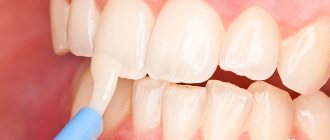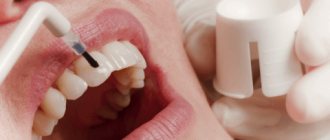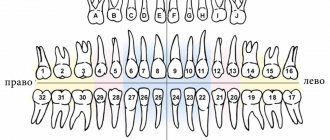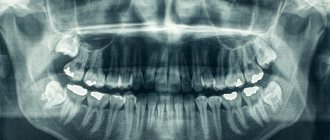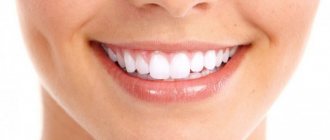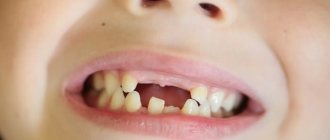The procedure of silvering teeth is the impregnation of areas affected by caries with silver, which strengthens dentin and enamel. In addition, silver disinfects the affected areas, eliminating cariogenic microorganisms, as a result of which the development of caries is suspended.
Most doctors prescribe silvering exclusively for children under 3 years of age who do not allow the dentist to cure the tooth. In most cases, the doctor manages to come to an agreement with older children, but much still depends on the dentist’s ability to find a common language with the little patient, calm him down and convince him that it won’t hurt. If the child is not afraid and fulfills the doctor’s requirements, then installing a filling will be a much more effective means in the fight against caries.
The development of caries in young children occurs much faster than in adults. First of all, carious formations affect the central incisors (mainly their front surface) and fourth teeth.
In children, caries, as a rule, is cervical, that is, covering the neck of the tooth with adjacent areas. A carious formation that appears in the first year of a baby’s life will develop to such an extent by the age of 2.5 that the crown of the tooth breaks off. Often caries is accompanied by the formation of fistulas and lumps, which indicates a purulent process occurring in the upper regions of the roots of the affected teeth.
CARIES OF MILK TEETH
Why are some children susceptible to dental caries, while others are not? Factors:
- genetic predisposition;
- poor quality nutrition;
- poor oral hygiene;
- frequent infection;
- Abuse of sweets.
Removing carious teeth is not a solution, since the absence of teeth in the jaw negatively affects the formation of the bite.
The enamel of baby teeth is not saturated with minerals, like that of permanent molars. The passion for sweets has a bad effect on the protective layer, and the tooth is affected by caries. A child’s teeth need constant strengthening and protection.
Therefore, parents should be attentive to the health of their child’s teeth, regularly show him to the dentist and take preventive measures - silvering of teeth.
Why do children get tooth decay?
There are many reasons for the development of carious formations:
- Insufficient mineralization of enamel. Baby teeth have porous enamel, which makes it more susceptible to destruction by cariogenic organisms. To strengthen the enamel, it is necessary to ensure that the child eats properly and receives all the necessary substances; a fluoridation procedure can also be recommended.
- Poor hygiene, exacerbated by the large amount of sweets and carbonated drinks with high sugar content consumed.
- Eating food contaminated with cariogenic bacteria. This happens when parents lick the spoon with which the child will later eat, or kiss him on the lips.
- Violation of feeding regime. You should not give food to your child at his first request. It is also forbidden to keep a bottle of sweet liquid near the baby’s crib, giving him the opportunity to constantly drink sugary drinks that destroy his teeth.
SILVERING OF MILK TEETH
Silvering protects baby teeth from the development of caries, and at the very beginning of carious decay. The surface of the molars is coated with a special solution containing silver, which hardens and forms a protective film.
The composition consists of antiseptic materials that destroy decay-causing bacteria. As a result, the teeth remain intact, and the child avoids treatment with a drill.
The child does not see scary dental instruments and does not feel pain - these are the advantages of silvering. If parents take them to the dentist before carious lesions develop, tooth decay can be completely prevented.
Advantages of silver plating:
- stops the development of caries;
- preserves the installed seal;
- protects sensitive teeth from the temperature effects of food;
- accessible to everyone;
- does not cause pain or discomfort.
Silvering is also indicated for those children whose parents are susceptible to severe dental caries. This procedure will save the child from the destruction of baby teeth.
Despite all the advantages, the procedure must be approved by a dentist, because silver plating has contraindications:
- the procedure is not effective when dentin is damaged, because the bacteria have penetrated deep into the tooth;
- does not always help prevent caries on chewing molars due to the complexity of the surface structure;
- requires preliminary cleaning of molars before coating;
- blackening of teeth.
Sometimes professional cleaning of molars before silvering can cause fear in a child. It is necessary to set the baby in a positive mood or somehow distract his attention.
Another significant reason for refusing silver plating is aesthetic inconsistency. After silvering, milk teeth darken and do not look aesthetically pleasing.
Is silvering baby teeth a panacea for caries? Unfortunately no. If the tooth has already undergone carious destruction, silvering can only delay the cleansing of the molar from traces of destruction and the placement of a filling.
The disadvantages include a peculiar aftertaste after covering the molars with a composition containing silver.
Important information about the silver plating procedure
- If caries has managed to overcome the initial stage and is already affecting the dentin, then silvering in this case will be a useless measure. Dentin in children is softer than in adults, and caries develops at twice the rate. When caries has entered the middle stage, even with silvering once a month there is no absolute guarantee that the lesion will not develop into pulpitis. Remember that silver plating is not a panacea! The procedure makes it possible to hold out until the child reaches the age of 3 years in order to carry out full treatment.
- Applying silver to exposed dentin can cause burns to the pulp, which will lead to the development of pulpitis, as the chemicals will be able to easily penetrate the nerve of the tooth. The onset of pulpitis is indicated by severe pain that is difficult to relieve. The doctor performing silvering must accurately calculate the time of application of the solution so as not to damage the pulp.
- Teeth treated with silver change their color, especially if their surface is treated with Russian or Belarusian preparations. The teeth take on a black tint, which looks extremely unaesthetic. Japanese-made solutions also change the color of teeth, but not to black, but to light gray, which is not so noticeable.
INDICATIONS
Do all children need the silvering procedure? There are a number of direct indications for the use of silvering:
- living in a region with water without fluoride;
- strengthening the molar after installing a filling;
- prevention of caries development on molars;
- violation of the integrity of the molar - crack, chip;
- a white spot on the crown of a tooth is the beginning of carious development;
- protecting sensitive teeth from food exposure;
- thin layer of enamel.
Advantages of the method
In addition to the absence of pain, silvering teeth in children has many more advantages:
- Treatment is carried out with an inexpensive drug and in a short time, which reduces the cost of the procedure.
- The solution is safe for children's bodies and is suitable even for infants.
- Preserves the development of caries.
- There is no risk of injuring the baby and creating a fear of treatment at the dentist.
Painlessness during the procedure is one of the main advantages of the method. The drug is applied without the use of dental instruments, using a soft applicator. This is very convenient for children 2–3 years old; it is at this age that caries first makes itself known.
CONTRAINDICATIONS
Firstly, the procedure is not performed if there is deep damage to the dental tissue. The composition of the drug is not intended to affect the internal tissues of the molar and may cause harm instead of benefit.
Secondly, the procedure is not carried out if there are existing pathologies of dental tissue or allergies to medicinal substances included in the solution.
Thirdly, coverage is not possible for existing somatic pathologies.
Fourthly, age from three years. Older patients undergo different treatment, for example, using a drill and placing a filling.
How often to do
Prevention and treatment of caries is a long process. Silvering of teeth in children is carried out at intervals determined by the doctor. The frequency of visits depends on the following factors:
- Method of feeding the child: breastfeeding, artificial feeding, are there cases of night feedings.
- Baby's age. After 3 years, it is advisable to resort to dental treatment using fillings.
- The level and ability of parents to carry out hygiene procedures.
- Condition of tooth enamel.
- The number of affected teeth and the degree of caries development.
Typically, teeth resilvering requires a follow-up visit within a week and three to five dental visits per year.
CARRYING OUT THE PROCEDURE
First, the dentist cleans the surface of the tooth so that no foreign particles from food remain on it. Then apply the mixture with a cotton swab and leave until hardened. They don't do anything else.
What is the coating solution made of? It contains silver nitrate - 30%. In dental practice, fluoride compounds can be added to silver nitrate, which have a strengthening effect on the enamel.
Note! The method of silvering baby teeth will need to be repeated several times. The dentist will notify you about this.
How many times does silvering need to be done? Sometimes this is done every three months, sometimes the baby needs to repeat the procedure every six months. What determines the frequency of the procedure? This is due to the type of feeding (breastfeeding or formula feeding) and the structure of the enamel of the molars. Thin enamel requires more careful care than durable enamel.
When is re-silvering required? The film wears off over time due to chewing of food. The silver film reacts to acids from food, so the child must be shown to the dentist regularly.
ARGENATE AND SAPHORITE
Modern dentistry suggests using drugs such as Argenate and Saforite containing silver fluoride diamine.
Argenate can be one-component or two-component. One-component is used to strengthen enamel and clog dentin tubules. The two-component drug has a similar effect for a longer period. It is used in the treatment of cervical caries, since the petroleum jelly contained in the composition protects the mucous membrane from burns by silver ions. After using Argenate, a dark film forms on the teeth, just like after silvering.
The drug Saforide is an analogue of Argenate of Japanese origin, therefore it costs many times more. In terms of the quality of the effect, it does not differ from Argenate. After imported drugs, teeth darken in the same way and are not cleaned with toothpastes.
Advantages and disadvantages of the procedure
Silvering has both supporters and opponents. Among the arguments in favor of carrying out the procedure:
- minimum stress for the child due to painlessness;
- speed of the procedure;
- safety (natural ingredients are used);
- price. Of the possible alternatives for restoring enamel, this is the most affordable.
- no need for pain relief or anesthesia;
- delay of illness. For some parents, the decisive factor is precisely the temporary one, since it makes it possible to wait until the child psychologically matures to another method of treatment. In this case, the disease will not progress.
The disadvantages include:
- aesthetic aspect, or “black” smile. The more teeth are silvered, the more noticeable the effect of the treatment. This is not acceptable for all children (and sometimes parents).
- short duration of action. Silvering is a safe procedure, but it does not last long. Over time, the silver nitrate film deteriorates, losing its protective properties. Therefore, there is a need to repeat the procedure.
- Silvering does not work for all caries. When a child has developed moderate caries or the degree of damage is already deep, this method will not work (the solution, when it gets on severely affected areas, harms the pulp) - it is necessary to look for other ways to solve the problem.
SILVER PLATING AT HOME
Many parents are interested in whether it is possible to silver teeth themselves? Dentists prohibit doing this, since without medical education it is impossible to carry out silvering correctly using dental preparations.
Silver plating can cause harm instead of benefit if it is applied to a tooth with deep carious lesions. It is impossible to independently determine the degree of tissue damage. Therefore, experimenting with treatment is strictly prohibited.
Another point is to clean the enamel from plaque. Parents will not be able to properly clean the surface of their teeth from plaque, so coating with a silver film “solders” the plaque to the enamel. After this, it will be difficult to clean the enamel from such a layer.
Drugs and costs
The main preparations for silvering teeth in children include the domestic “Argenat” and “Saforaid”, produced in Japan. The first solution is available in one- and two-component forms. Contains silver fluoride diamine. When interacting with calcium ions, it forms calcium fluoride and silver orthophosphate, which have a bactericidal effect.
It is believed that the Japanese drug contains an ideal combination of fluorine and silver ions. Its disadvantage is its high price, an order of magnitude higher than that of Argenat.
The cost of the service depends on the degree of damage, location and level of the clinic, and the drug used. The lower price threshold starts from 30 rubles and ends in the range of 680–800; on average, the procedure costs 150 rubles per tooth. In dental clinics, services for children can be provided free of charge, if this is provided for by the Territorial Compulsory Medical Insurance Program.
PSYCHOLOGICAL PROBLEM
Some children may react negatively to changes in enamel color after silvering. Therefore, it is important to have a preliminary conversation and explain to the baby that dark teeth are better than sick ones. If you clearly tell your child that after plating you won’t have to drill your teeth with a drill, he will be able to understand the importance of silvering.
You can convince the baby that now he will not have black teeth, but silver - precious ones. Many children manage to overcome the ridicule of their peers and become confident in the correctness of their choice. After this, the situation changes, and peers stop pointing fingers at black teeth.
Minuses
- If you neglect to thoroughly clean your teeth before the procedure, it may not give the desired effect.
- After silvering at the site of application of the drug, the enamel acquires a stable dark or black color if solutions produced in Belarus and Russia are used. Treatment with Japanese “Saforaid” gives the teeth a light gray or brownish tint. It is impossible to return the previous whiteness. The blackening of teeth in the photo before and after silvering often makes parents doubt the need for the procedure.
- Treatment is time-consuming and the process cannot be completed in one day.
- There is a risk of pulp burns and allergies.
- Silver plating is not suitable for chewing teeth.
ALTERNATIVE
Silvering of teeth is an outdated, but still popular method of teeth preservation in Russia. What can replace silver plating? For this, dentists have developed alternative methods:
- remineralization;
- fluoridation;
- ozonation;
- fissure sealing.
REMINERALIZATION
Remineralization can be done either in the dentist's office or at home. A special solution is applied to the surface of the molars, which strengthens the enamel structure. The composition of remineralizing mixtures includes a fluoride component. Dental tissue is saturated with minerals and completely restores its structure. The disadvantage of the technique is the age of the child - only after six years.
FLUORIDATION
Fluoridation of teeth can be deep and superficial. Surface fluoridation coats the enamel with a thin protective film. Deep fluoridation using electrophoresis achieves a different goal - strengthening enamel structures. This method can defeat the onset of caries, as it fills the destroyed cavity with structural material. Compared to silvering, this is a more radical method of protecting molars from caries.
Advantage of fluoridation:
- replaces silvering;
- strengthens the enamel structure;
- fills micro cracks in enamel;
- does not change the color of teeth;
- carried out no more than once every 6 months;
- restores enamel after carious lesions;
- indicated for children from two years old.
Deep fluoridation protects molars for a year, then the procedure is repeated. Of course, there are contraindications to fluoridation. For example, fluoride intolerance or excess fluoride in drinking water. Also a contraindication is multiple carious lesions of molars.
OZONATION
Ozonation is carried out by a dentist. The essence of the procedure is to prevent carious lesions of molars and destroy putrefactive bacteria in the oral cavity. The oral cavity is completely cleansed of putrefactive bacteria, and then the teeth are coated with a protective substance. Ozonation can completely replace remineralization and silvering if caries has just begun.
SEALING
Fissure sealing with tension can be called a protective procedure, since only the chewing side of the molars is subject to coating. A special solution is applied to the chewing grooves, which prevents the destruction of the enamel. Sealing is carried out for both therapeutic and preventive purposes.
Alternative methods
Medicine is developing rapidly, so many clinics offer other methods of painless treatment and prevention of caries. If there are contraindications to the silvering procedure, the following options can be used:
- Remineralization . The affected part is treated with fluoride-containing preparations by spraying, after which the tooth tissue becomes strong due to the formation of a mineral film. Unlike silver plating, fluoridation preserves the color of the enamel.
- Ozonation . It is a method of treating teeth with ozone. In the process, a significant part of pathogenic microorganisms is destroyed. Requires repeated repetition for greater effectiveness.
- Sealing tooth fissures . The method combines preventive and therapeutic effects. The tooth cavities are filled with a sealant-type agent, which prevents the subsequent development of the carious process. The drug also contains microelements and minerals necessary for enamel.
- Treatment with a drill . To make the process painless, pediatric dentists use ointments and sprays that have a local anesthetic effect. If the doctor is experienced and can establish contact with the child, the treatment will take place without pain and stress, and subsequently the child will not be afraid to have his teeth treated.
The listed methods are mainly suitable for children from 3 years old; their cost is much higher than the price of the silvering procedure.
Important! The choice of treatment method is influenced by many factors: how much the service costs, what the tooth looks like after it, whether the child hurts or not during treatment, and whether a durable coating is formed with each method. But a specialist must decide whether to silver a child’s teeth or not.
WHAT IS BETTER - SILVER OR FLUORIDATION
Fluoridation (deep) strengthens the enamel structure and accelerates remineralization. This technique helps well with primary caries and for preventive purposes.
Benefits of fluoridation:
- low cost of treatment;
- can be used to treat infants and young children;
- extends the service life of fillings;
- does not change the color of the enamel;
- carried out quickly.
Disadvantages of fluoridation:
- repeating the procedure is required;
- has contraindications;
- requires careful oral hygiene.
After fluoridation, tooth enamel is strengthened, which provides good protection against the penetration of pathogenic bacteria. Any cracks in the enamel are a pathway for infection; strengthening the enamel naturally protects the crown from damage.
The method is carried out in two ways - by applying disposable trays and using electrophoresis. The mouth guard method is the application of a protective agent to special dental guards. This method is superficial, since the substance does not penetrate into the deep layers of tissue.
Electrophoresis allows fluoride compounds to penetrate into the deep structures of the enamel, which increases the effectiveness of the procedure. However, this method has contraindications, so it is not suitable for everyone.
Fluoridation reduces the risk of dental caries by 60%.
Silver plating has the same benefits as fluoridation. However, the disadvantages include a change in the color of the enamel. A significant disadvantage of silver plating is the inability to monitor the development of caries under the film. Also, silvering can be dangerous if done incorrectly - silver ions have a detrimental effect on the pulp upon penetration.
What to choose? The dentist must choose the correct method based on a thorough examination of the child’s dental condition and health. Fluoridation is strictly contraindicated if drinking water contains a high fluoride content. Silvering and fluoridation are preventive measures and can only stop the development of carious lesions - drilling and filling cannot be avoided anyway.
If micro cracks have formed on the enamel, it is better to use remineralization. This procedure will restore the deformed layer and help avoid infection.
Advantages of the technique
When talking about the benefits of silvering as a method of caries prevention, it is customary to emphasize the following:
- the child does not experience pain;
- the service is cheap;
- the composition used is safe for health;
- therapy takes little time;
- no need to use local or general anesthesia;
- it is possible to extend the service life of milk units.
Despite all these advantages, silver plating is used less and less today. And there are reasons for this.
RESULT
Silvering is carried out in order to prevent further carious damage to the tooth. Silver has antiseptic and antibacterial properties, which helps protect enamel from the destructive activity of microorganisms. However, the procedure must be carried out regularly, since the silver film wears out quickly. The method is outdated, so instead of silvering, you can choose an alternative technique - ozonation, remineralization or fluoridation.
However, none of the listed methods eliminates the cause of caries. Remember that the strength of dental tissue depends on the immune system, so strengthening the immune system is a top priority. Proper nutrition, taking vitamin and mineral complexes, hardening and reducing the amount of sweets is an important point in shaping the child’s health. Immediately after the first teeth erupt, take care of your baby’s oral hygiene; as he gets older, teach him to brush his teeth on his own.
How Reconstituted Silver Works
The composition impregnates dental tissues, due to which they become denser and more resistant to negative external factors. With initial and superficial caries, the medicine penetrates deep into the pores of the enamel and, as it were, clogs them.
The drug not only increases the stability of dental crowns, but also has a pronounced antibactericidal effect. With its help, you can disinfect your mouth and destroy pathogenic flora in a carious cavity. But to achieve maximum results, one treatment is usually not enough - it must be repeated several times.
How children's teeth are silvered
First, the doctor removes soft plaque from the little patient’s teeth. Afterwards, if necessary, cleans the hole from food debris and altered dentin using a hand tool. At the same time, it removes the edges of damaged enamel overhanging the cavity. This is necessary so that the caries takes the form of an empty deep bowl. Only then will food residues not accumulate in it.
The next stage is isolating the processed unit from its neighbors. Otherwise, nearby teeth will also become black. The dentist then takes a silver solution and applies it to the damaged enamel.


